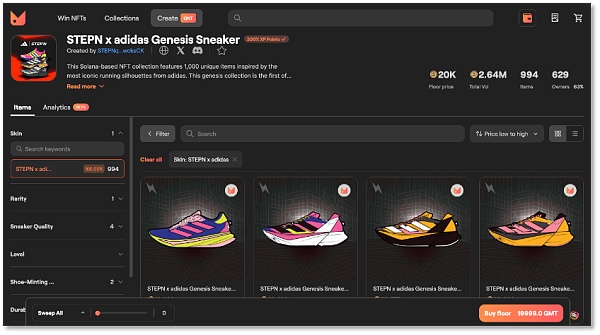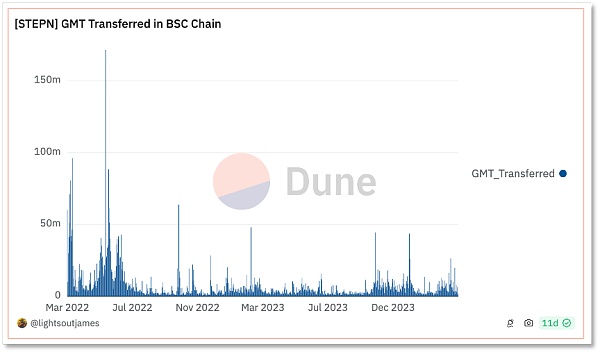Source: Metaverse Daily Explosion
It is difficult for old players in the Web3 world not to know StepN. Recently, this Web3 application that once promoted the "Move To Earn" gameplay to the world has finally made new moves after two years of silence: On April 15, StepN announced a partnership with the well-known sports brand Adidas to launch a gameplay that combines physical objects and NFTs, returning to the vision of NFT users.
In 2022, StepN, which "let 3 million people own their first pair of virtual shoes", was popular all over the world. Track and field enthusiasts in Japan, Singapore, the United States, the United Kingdom and even many parts of China received a pair of "NFT sneakers" from StepN in a "walking and earning" way. So far, the mileage of walking or running is no longer just a "competition for exposure" in the circle of friends, but can also be realized through NFT.
By transforming the popular "Play To Earn" model in GameFi, StepN's "Move to Earn" gameplay quickly became popular, especially attracting those Web2 users who are happy to share their "daily steps" in WeChat Moments or sports software.
Unfortunately, the good times did not last long. In May 2022, StepN suddenly announced the withdrawal of users from mainland China, and the relevant crypto assets in the application ecosystem plunged. The "death spiral" that GameFi projects had long experienced fell on StepN. Since then, the downhill road has become a journey that the application cannot escape.
The news of the cooperation with Adidas has brought StepN back to the spotlight, and the application has begun to empower its governance token GMT again. The development team Find Satoshi Lab launched a chain game Gas Hero last year, and GMT has also added another application scenario, namely game tokens. After two years of fading halo, can StepN, which has joined hands with the big IP Adidas, reproduce its past myths?
01 StepN joins hands with Adidas to focus on big IP again
The NFT sneakers launched by StepN and Adidas are called "STEPNxAdidas Genesis Sneakers". According to public information, the sneaker NFT series is built on the Solana chain and contains a total of 1,000 items, inspired by Adidas' most iconic running shoe silhouette.
 The NFT sneakers launched by StepN and Adidas have been minted
The NFT sneakers launched by StepN and Adidas have been minted
So far, 1,000 running shoes NFTs of the STEPN x adidas Genesis Sneakers series have been minted on the launch market MOOAR, with a successful minting volume of 994 and a number of holder addresses of 629. The token used to consume this series of NFTs is StepN's governance token GMT. Currently, the floor price of this series of NFTs is 20,000 GMT, and the secondary market price of GMT is temporarily reported at $0.24. Then the floor price of STEPN x adidas Genesis Sneakers NFT is equivalent to $4,800.
It should be noted that on April 17, the unit price of this NFT when it was distributed by lottery on MOOAR was still 10,000 GMT, which was about $2,500 at the time. As of April 25, the floor price of this NFT has doubled in GMT, and in USDT (US dollar stablecoin), the floor price has increased by 92%.
The users who hold this NFT and directly benefit from the increase in the floor price are mainly community members led by Adidas and StepN developer Find Satoshi Lab (FSL). These are whitelisted users of the lottery distribution method. It is reported that they will also receive exclusive benefits. Prior to this, StepN also launched a $30 million airdrop campaign for loyal players and ecological asset holders.
From the above dynamics, the launch of the STEPN x adidas Genesis Sneakers series is more like a sticky event for old users.

Dune data also shows that StepN's user activity increased before and after this launch event, but if these curves are compared with the data before August 2023, this rebound in activity is just a "small wave".
02 The heavy blow of "death spiral" has not yet been repaired
StepN's highlight moment was terminated in May 2022. The project announced "corresponding regulatory policies to stop GPS and IP location services for mainland Chinese users", officially ending its operations in the Chinese mainland market. What followed was a plunge in the project's ecological tokens GMT and GST and a halving of the price of NFT sneakers. The "death spiral" that the GameFi project could hardly escape was also beginning to approach it.
 StepN's GMT experienced a brief peak in 2022 and then fell silent
StepN's GMT experienced a brief peak in 2022 and then fell silent
Like another phenomenal blockchain game Axie, the "dual token" economic model failed again in StepN. In its economic system, the unlimited supply of GST is a reward generated when users exercise, and its main purpose is to upgrade the gaming experience, such as generating, repairing and upgrading NFT running shoes; while the total supply of GMT is about 5.368 billion, which is defined as a governance token, mainly used for trading NFTs or as collateral for financial scenarios in games.
StepN needs to find a way to keep the output and consumption of tokens in a relatively balanced state. However, GST has unlimited supply but limited scenarios, which means that GST is likely to produce more than it consumes; while GMT not only has limited scenarios, but its value is also strongly bound to NFT. Once GMT or NFT depreciates rapidly, it may cause a big plunge in the value of both assets, thus forming a vicious cycle.
The news of "sudden withdrawal" in May 2022 became a fuse, and the asset selling behavior of the cleared users quickly exposed the defects of StepN's dual-token model.
Up to now, StepN still maintains the dual-token model, and the way out it finds for itself is to increase the application scenarios of tokens, especially for GMT, which can better represent the market value of the project.
In order to activate the GMT ecosystem, StepN has made a lot of efforts.
First is the "joint strategy". At present, GMT is the voting token for members of the NFT market MOOAR. Member users of the market can use GMT to vote for pre-released NFTs on the "Launchpad" of MOOAR's new section. Users who vote successfully have the opportunity to obtain the right to mint new NFTs. This approach adds application scenarios for GMT.
In addition, MOOAR members can also use GMT to trade NFTs or create AIGC NFT collections. This approach is to increase the consumption of GMT.
In addition to the external alliance, StepN is also creating new use scenarios for GMT within the ecosystem. At the end of last year, the development team Find Satoshi Lab launched the chain game "Gas Hero". The game did not issue new tokens and directly used GMT as a consumable token in the game, such as strengthening game characters. The development team also took out about 2 million GMT to reward the creators of game characters and promised to pay 2% royalties.
Increasing scenarios and increasing consumption, with the efforts of StepN, GMT gradually rebounded from the lowest point of US$0.1 to US$0.24. The token's year-to-date increase recorded by Coingecko was -26.5%, and on April 28, 2022, GMT's highest point was US$4.11.
Scenario empowerment does not seem to have brought about essential changes. It is worth noting that after StepN and Adidas cooperate on NFT, the two parties will also jointly launch physical products. There have been successful cases of NFT IP taking the physical route. The Pudgy Toys launched by the NFT series Pudgy Penguins have been welcomed by ordinary consumers and once promoted the sales of native NFTs.
As a once phenomenal product, StepN has accumulated a user base in the previous cycle, which is its advantage. After joining forces with a big IP like Adidas, compared to issuing new shoes NFTs to win over old users, the more important direction is to leverage the power and go out of the circle again, so that it can become a more extensive and innovative IP. After all, traffic can bring the amount of funds to promote the value of encrypted assets in the ecosystem.
 JinseFinance
JinseFinance
 JinseFinance
JinseFinance TheBlock
TheBlock Coindesk
Coindesk decrypt
decrypt Beincrypto
Beincrypto Beincrypto
Beincrypto Cointelegraph
Cointelegraph Cointelegraph
Cointelegraph Cointelegraph
Cointelegraph Cointelegraph
Cointelegraph